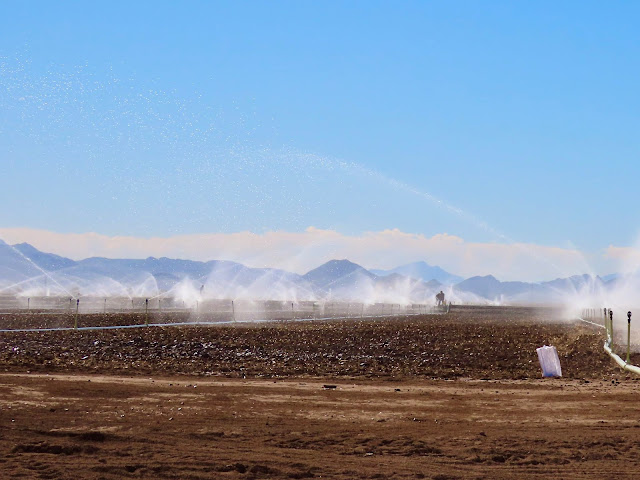Saturday, January 23, 2021
With Hinde Silver joining me early this morning, we set out on my third successive Saturday to test an economical driving route through the Flats from a new North entrance. There are limits on birding and the public in general when driving Santa Cruz Flats. Today, sticking to paved and named roads on the online overview map, gave us a feeling of “private birding” on public land. (Much of it leased for farming activities with ag roads being off-limits). The 300 square miles of former grasslands, now desert scrub and watered agricultural land, is definitely a place to visit during the pandemic: more birds than people!
There are two main routes for entering the Flats from the North: Picacho Highway or the one I prefer, Barrett. If you live far enough east that Ironwood Road works as a shortcut for going south to I-10, this new route skips I-10. After going through Coolidge on Route 87, just pass over the I-10 entrance and stay on the road marked to Picacho. This road will curve around a bit and end at a stop sign at an unmarked road (Phillips on the Santa Cruz Flats map). By turning left at the stop sign, I found Barrett on the right within 50 yards, to be the perfect place to enter the Flats to begin birding. It’s a wide dirt road with cultivated pecan trees on the left and scrub desert on the right. We were birding within an hour of leaving home without any zoom zoom traffic.
Although the sun had not yet hit the area many sparrows, Abert’s Towhee, and a few Western Meadowlark were moving around hidden in the “scrub” side of Barrett. Two RED-TAILED HAWK, perched in the pecan trees and as the sun rose more and more birds headed for that area. Photos below: RED-TAILED HAWK and LOGGERHEAD SHRIKE.
Since the Flats are laid out in a grid, you can’t really get lost (Picacho Peak is a good landmark for the east side). The problem becomes when the roads don’t connect; thus my several trips to get a good route going from the North entrance. With a few more adventures today, I’ve re-marked my map and am ready to say I have a handle, more or less, on the east side (north and south) over to Curry Road, as far west as we traveled. I had been tempted to go farther but it was there that we came upon two birders from Tucson with their scope set up at the edge of Pretzer Road.
I asked if they were looking at MOUNTAIN PLOVER. They thought so! Using their scope, I confirmed their sighting but didn’t swing the scope back and forth to see the total flock number. I counted twelve in that one view. They (our only humans of the day) were our source for sending us immediately back east. We hadn’t yet gone south there, but upon hearing a great number of CRESTED CARACARA were in a field being plowed by a farmer, we high-tailed it over there to see if the farmer was still at work. The fields were reasonably close to Baumgartner/Wheeler to use that eBird Hot Spot for our sighting of 41 CRESTED CARACARA at their Saturday morning buffet.
With each of us carrying a point-and-shoot Canon SX70, the birds were at a distance that would cut down on the sharpness of our photos, as did the overcast sky. Photos below.
Just by driving the roads throughout the eastern side of the Flats, we accumulated a total of 40 species for the day. There were two more Red-tailed Hawk that I photographed (they come in many varieties of subspecies).
While COMMON RAVEN can easily number in the hundreds there, today we spotted only 22. Thus, was tempted to take a photo!
Missed a photo of the GREATER ROADRUNNER when it scooted across the dirt road in front of the car, but did stop for one of my favs perched on a barbed wire fence:
VERMILION FLYCATCHER.
WESTERN MEADOWLARK, strangely, were perched in a tree along that same road.
But, my "Bird of the Day" was the one below: a MERLIN -- a small falcon I rarely see. It's larger than an American Kestrel but smaller than a Cooper's hawk. We saw this "Prairie" subspecies female that lacks male's blue wings and back. Her feathers are an all-over brown color; she was looking very calm and relaxed. When she finds prey, it's quick...out on the wing and Bingo! Gotcha! No hovering as with the American Kestrel. We had seen one earlier overhead doing just that and may have picked up a Horned Lark we'd already counted.
Wrapping up our all-around excellent day of birding by driving North on Picacho Highway, we returned on the appropriate roads (turning left when reaching the dead end at I-10), to return home over the I-10, back through Coolidge on a reverse course from earlier in the day.
I'm thinking there may be one more trip to Santa Cruz Flats to visit the west side from the north entrance unless they get rained out during the week. One trip through the mud was enough!
Till then,
See eBird links below:
View this checklist online at https://ebird.org/checklist/S79750105
View this checklist online at https://ebird.org/checklist/S79752611
View this checklist online at https://ebird.org/checklist/S79756062
View this checklist online at https://ebird.org/checklist/S79761725
View this checklist online at https://ebird.org/checklist/S79764406






















































